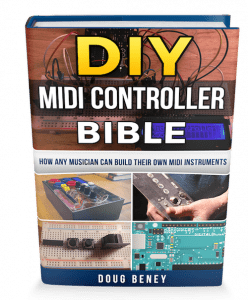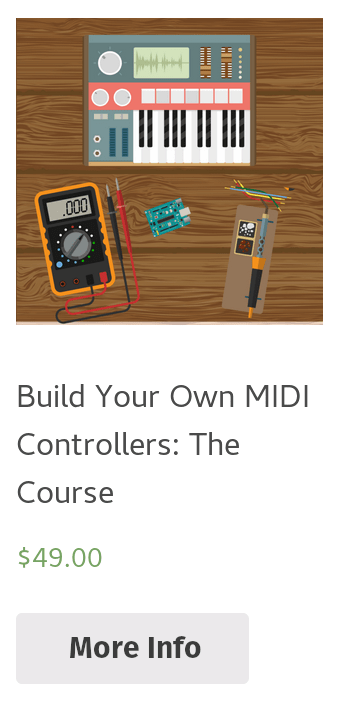DIY MIDI Controller Bible / Course Review – Does This Guide Live Up To Its Expectations?
Full Disclaimer: MIDI Lifestyle is owned by the same company as DIYMIDIController.com. However, we tried our best to provide an honest overview. If you have any comments, questions, or want to leave your experience of the DIY MIDI Controller Bible/Course, feel free to drop a comment below.
UPDATE 2017: The DIY MIDI Controller Bible relaunched as a course.
Book Name: DIY MIDI Controller Bible
Where to Buy: DIYMIDIController.com
Short review: Everything you need to know about circuitry, programming, and building MIDI controllers, explained in a simple way that any musician can follow along with. Tons of value and love that sample code and schematics are included in full resolution as an additional download
The nature of technology is one of rapidly increasing progress.
For everything a person learns, it seems that someone else takes things four steps ahead. While most of us struggle to use technology, others apply and expand, after which they sell the “new” and improved technology back to us so we can learn something new all over again. Then, someone else does the same, and so on. Just look to Apple and the iPhone as evidence of a phenomenon in the Real World.
MIDI and the Changing World of Music
For myself, I was pretty happy to be in on MIDI about 10 years after the first discussions of a universal language for electronic musical instruments began. I’m old enough to feel that being a decade behind time feels progressive.
The fundamental reason for this language, called Musical Instrument Digital Interface, was to bring compatibility across manufacturers’ platforms. In essence, it was so synthesizers could play nice together, everyone could get along and, at least in the keyboard universe, there is “world peace”.
That first conversation was in 1981. By 1991, General MIDI standard song files came along, which was the time my learning curve edged up. Grasping maybe 1/100th of what MIDI could do, I started sequencing and incorporating MIDI into recording.
Of course, real musicians had already been doing this for years at a much more advanced level. MIDI control spread to other devices beyond keyboards. In fact, keyboards were no longer necessary in every MIDI instrument, since any instrument could “talk” with any keyboard.
For many musicians, myself included, it was enough that MIDI worked. The “how” was never important.
Electronics Hobbyists — Breadboards and Beyond
I’ll date myself even further by referencing the Heathkit. This was a magical toy of my youth, a box with pre-digital electrical components on it, each with a little spring connected to the leads. I’d read from a book that told me to take a brown wire from the set and connect it between the springs at the conveniently identified R12 and C21 locations.
Add enough of these wires as directed in the book and a person could create all sorts of electrical devices. A person with a sharper mind than mine might even learn what would happen when the wires get connected in certain ways.
In later years, I expanded my repertoire, learning to etch circuit boards and solder components to them to create guitar effects, again following instructions in a book, not really getting what was going on, though I was very happy when my trial and errors worked.
Flash forward to today and the tech wonderland in which we live, the primitive times of the Heathkit and early days of MIDI are far behind, but the legacy of those electronics kits and the power of MIDI are still here.
Enter Doug, his e-book, DIY MIDI Controller Bible and the Arduino.
Ardu-What-O?
My little Heathkit had transistors. Two of them, if memory serves. Transistors are those things that now exist in the kazillions on integrated circuit chips. I had two.
When I first encountered an Arduino, the connection to the primitive electronics kit of my distant childhood was immediately obvious. An Arduino is a digital Heathkit!
Despite my need to painfully oversimplify things, the analogy holds. Except now, of course, there are more than two transistors.
And despite the fact Doug writes about MIDI uses for the Arduino, there’s nothing inherently MIDI in the Arduino’s workings. It’s a computer chip version of that electronic kit of old.
Now, of course computer chips require programming to know what to do. Well, it turns out this Arduino thingie has a language that lets you tell it what to do. That’s all very nifty, but what does it mean to a functional idiot such as me?
This is Where Doug Comes In
Doug is not a functional idiot. He does, however, have the ability to communicate with functional idiots on my level. When it comes to explaining how the Arduino accepts instructions, that is, its programming language, he uses something even I can understand. Breakfast cereal.
Anyone who has tried and failed to learn a programming language understands the frustration. The first value of the DIY MIDI Controller Bible comes from Doug’s ability to turn breakfast cereal into an explanation of the Arduino’s programming language.
The second value of the DIY MIDI Controller Bible comes when you find that Doug includes the code in your e-book purchase. If, like me, your eyes sometimes cloud over when talk of programming begins, you’re not excluded from playing with an Arduino.
There are those out there who eat that programming stuff right up and do it for you. You get to play mad scientist, connecting this to that, vaguely wondering if everything will explode at some point, secretly hoping it does, but not so violently that it spills your Dr. Pepper, and you can upload programming code in a fashion similar to Dr. Frankenstein energizing his monster in a lightning storm.
Maybe that’s just me though.
Parts and Stuff
Once the basics of code are examined, Doug explains where to get the goods. Arduinos (and Genuinos, the European version) are open source hardware. As the book explains, though Arduino is the developer of the hardware board, anyone can manufacture and sell their version of Arduino’s open source circuit configuration.
Chinese factories create quite legal knockoffs for very low prices, so Arduino projects can be quite an affordable hobby. As Doug points out, buying at least one board from Arduino itself does help ensure that the future of the device and others like it continues.
DIY MIDI Controller Bible uses the Arduino Uno board, and, to follow with the book, you need a board that matches this layout precisely, so this is another good reason to start with an authentic Arduino board.
Additional components needed for each project are clearly noted alongside each project. Seems obvious, but I’ve encountered many DIY manuals that bury what you need in the back pages, often numbered incorrectly. While you’re probably not as fundamentally confused as I am, it’s a nice touch to have the info you need right at hand.
The Projects
The meat and potatoes of any publication like the DIY MIDI Controller Bible are the projects. Doug structures the projects logically, adding information as it’s needed. There’s nothing like context to introduce new concepts, and Doug grasps this perfectly.
The first project, a simple MIDI controller, demonstrates the assembly and programming in separate steps, perfect for both the keener who wants to get to the playing as fast as possible and the serious student, intent on learning how to program the Arduino.
Doug even understands the Dr. Frankenstein urge and explains that copy-and-paste of programming code is kosher.
Each project builds on the previous concepts, and as it gets more complex, new methods, techniques and ideas are explained carefully.
Rather than stuffing the book full of random MIDI projects, Doug has chosen logical and sequential projects that guide the reader through the concepts necessary to not only understand the project, but also how to interpret that understanding into bigger concepts.
Many DIY books function on a “do-this-and-it-will-do-that” basis. There’s cause and effect, but no reasoning or, when explanations are available, these come after the project, so The Idiot (i.e. Me) is beeping and booping and couldn’t care less about the “how” anymore. By presenting the concepts in a logical way, Doug assures that even The Idiot picks up some theory as he races toward the end of the project.
This doesn’t come at the expense of the “build it and play” reader. Skipping the programming or conceptual material that induces brain hurt doesn’t affect your ability to complete the projects, as long as you follow the construction instructions and upload the copied code properly.
Don’t be surprised if you accidentally learn something on your way to beep and boop nirvana.
Value for the Money
Okay, I’ll be honest. When I saw the price on the DIY MIDI Controller Bible, I was skeptical. There didn’t seem to be that many projects to justify a $50 price tag.
Then, I read the book.
Don’t let the title fool you. While it deals with MIDI controllers, in reality it’s a complete Arduino hobby guide that simply uses MIDI as the focus for how you will use an Arduino to complete tasks. Everything is in there:
- Using bread boards
- How components work
- The logic and flow of programming
- Connecting projects to computers for both programming and use
- Using perf board
- How to solder
- Planning and building enclosures
You’re not getting just a few MIDI projects. You have an entire course load of info. If you proceed through all projects in this book, you’ll likely end up with ideas to solve whatever MIDI related application issues you’ve been carrying for years, or fomenting plans for a revolutionary new music controller.
Doug’s style is deceptively easy-going for the sheer volume of information he presents. Forget my first impression. The $50 price tag is a bargain. Beep and boop heaven is at hand. The DIY MIDI Controller Bible makes it simple.


Leave a Comment